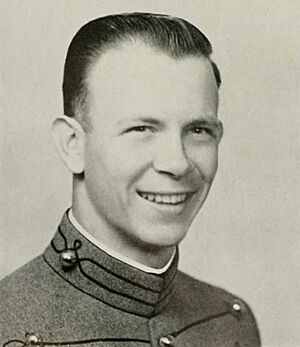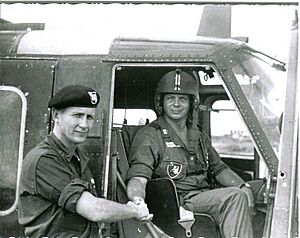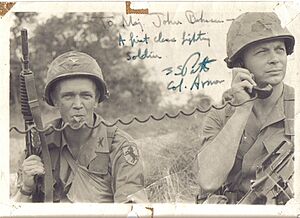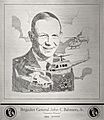John Bahnsen facts for kids
Quick facts for kids
John C. Bahnsen, Jr.
|
|
|---|---|
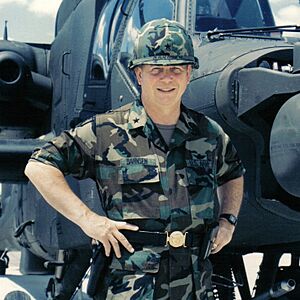
Bahnsen as Brigadier General, early 1980s
|
|
| Nickname(s) | Doc |
| Born | November 8, 1934 Albany, Georgia, U.S. |
| Died | February 21, 2024 (aged 89) Rochelle, Georgia, U.S. |
| Allegiance | United States of America |
| Service/ |
|
| Years of service | 1956–1986 |
| Rank | |
| Commands held | Bandit Platoon, 118th Assault Helicopter Company Air Cavalry Troop, 11th Armored Cavalry Regiment 1st Squadron, 11th Armored Cavalry Regiment 1st Battalion, 32nd Armored Regiment 1st Aviation Brigade |
| Battles/wars | Vietnam War |
| Awards | Distinguished Service Cross, Silver Star (5), Distinguished Flying Cross (3), Legion of Merit (4), Bronze Star (4), Air Medal (51), Purple Heart (2), Meritorious Service Medal |
| Other work | Consultant, writer, gentleman farmer |
John C. "Doc" Bahnsen Jr. (November 8, 1934 – February 21, 2024) was a highly decorated United States Army officer. He reached the rank of brigadier general. He was known for his bravery and leadership during the Vietnam War.
Contents
Early Life and Education
John Charles Bahnsen Jr. was born in Albany, Georgia, on November 8, 1934. His family later moved to Rochelle, Georgia, in 1941. His father worked there to help conserve soil.
John's nickname, "Doc," came from his grandfather, Dr. Peter F. Bahnsen. Peter was Georgia's first state veterinarian, a doctor for animals.
John attended public schools in Rochelle. He later moved to Americus to get more math and science classes. After that, he went to Marion Military Institute in Alabama. He was then accepted into the United States Military Academy at West Point.
Life at West Point
Bahnsen started his studies at West Point in 1952. He was a good athlete, especially in pole vaulting. He also played wrestling, lacrosse, swimming, football, and soccer.
At West Point, Bahnsen met George S. Patton IV and Hank Emerson. These officers became his mentors. Bahnsen was very good at military and physical education courses. He graduated on June 5, 1956, as a Second Lieutenant.
Starting His Military Career
After West Point, Lieutenant Bahnsen went to Airborne School. This school teaches soldiers how to parachute from planes.
He married his childhood sweetheart, Patricia Fitzgerald. They had four children together.
Bahnsen's first assignment was in West Germany. He became an aviator, flying aircraft for the Army. He later switched to the Armor branch, which deals with tanks and armored vehicles. He was very good at leading his tank company. All 17 of his company's tank crews passed their qualification course on the first try. For this success, he received the Army Commendation Medal.
He continued his training, learning to fly helicopters. He also taught tactics for armored and air cavalry units.
First Tour in Vietnam
In October 1965, Bahnsen went to Vietnam. He commanded a group of gunship helicopters called the "Bandits." One important mission involved supporting Marine Aircraft Group 36. For this, he earned his first of five Silver Stars. The Silver Star is a high award for bravery in combat.
His brother, Peter, was also in Vietnam at the same time. They even flew on at least one helicopter mission together.
Bahnsen later became an operations officer and was promoted to major. He created a "Top Gun" competition to help helicopter pilots improve their shooting skills.
During his time in Vietnam, Bahnsen had a son named Minh. Minh later moved to the United States and met his father. Minh Bahnsen has worked in the film industry as an electrician and grip. He worked on movies like National Treasure and Thor.
Working at the Pentagon
In December 1966, Bahnsen started working at The Pentagon. This is the headquarters of the U.S. Department of Defense. He checked if aviation and air cavalry units were ready for deployment to Vietnam.
In April 1968, he helped patrol Washington, D.C., during the unrest after the assassination of Martin Luther King Jr..
Bahnsen reconnected with George Patton IV at the Pentagon. When Patton went to Vietnam to lead the 11th Armored Cavalry Regiment, he arranged for Bahnsen to join him.
Second Tour in Vietnam
Bahnsen arrived back in Vietnam in October 1968. He took command of an Air Cavalry troop. This troop had different types of helicopters: UH-1 "slicks" (for transporting troops), OH-6 scout helicopters, and AH-1 gunships. It also had an infantry platoon.
His troop was involved in daily combat. Bahnsen often flew his helicopter during battles. He also joined his soldiers on the ground to lead attacks. His reputation for courage and leadership grew during this time.
In January 1969, a white phosphorus grenade exploded inside Bahnsen's helicopter. Crew member Rodney J. T. Yano was badly burned. Ammunition inside the helicopter started exploding. Even though Bahnsen was injured and couldn't see well, he kept throwing the burning ammunition out. Yano died, but his actions saved the helicopter from crashing and protected the rest of the crew. Yano received the Medal of Honor for his bravery. Bahnsen worked hard to make sure Yano was honored.
In the same month, Bahnsen landed his helicopter under enemy fire. He directed artillery fire and led a ground attack. For these actions, he received the Distinguished Service Cross. This is a very high award for extreme bravery.
Bahnsen later commanded the regiment's 1st Squadron. This unit was usually led by a higher-ranking officer. Bahnsen was the only major to command a squadron in the 11th Armored Cavalry Regiment during the Vietnam War.
His squadron fought in many areas, including the Iron Triangle. Bahnsen finished his second tour in Vietnam on September 8, 1969. He received his fifth Silver Star for a major battle just before he left.
Bahnsen believed that the U.S. and its allies were winning the war. He felt that political decisions prevented a military victory.
After Vietnam
After Vietnam, Bahnsen was promoted to lieutenant colonel. He commanded a tank battalion in West Germany from 1969 to 1971.
He then attended the United States Army War College. He also earned a master's degree in public administration.
Bahnsen later worked on developing new training methods for the Army. One of his biggest successes was the Multiple Integrated Laser Engagement System (MILES). This system uses lasers to simulate combat, making training more realistic. It is still an important training system today.
He was promoted to colonel and then to brigadier general. He held several important leadership roles. These included commanding the 1st Aviation Brigade and serving as Chief of Staff for the Combined Field Army in South Korea.
His last assignment was Chief of Staff for the III Armored Corps at Fort Hood.
Retirement and Later Life
Bahnsen retired from the Army in 1986. He worked as a consultant for military and defense companies.
He and his wife, Peggy, settled on her family farm in New Cumberland, West Virginia. They raised corn and other crops to feed wildlife like quail and deer. Bahnsen also enjoyed fishing and hunting. He raised and trained English pointers, which are hunting dogs.
Bahnsen remained active with his West Point class. He also gave lectures on leadership to Army audiences. He passed away from heart failure at his home in Rochelle, Georgia, on February 21, 2024, at the age of 89.
Awards and Honors
Bahnsen was one of the most highly decorated officers of the Vietnam War. His awards include:
 |
|||
 |
|||
| Army Master Aviator Badge | |||||||||||||
| Parachutist Badge | |||||||||||||
| Distinguished Service Cross | Silver Star with 4 bronze oak leaf clusters |
||||||||||||
| Legion of Merit with 3 bronze oak leaf clusters |
Distinguished Flying Cross with 2 bronze oak leaf clusters |
Bronze Star with Combat V and 3 bronze oak leaf clusters |
|||||||||||
| Purple Heart with 1 bronze oak leaf cluster |
Meritorious Service Medal | Air Medal with Combat V and Award numerals 51 |
|||||||||||
| Army Commendation Medal with Combat V and 3 bronze oak leaf cluster |
National Defense Service Medal with 1 bronze service star |
Vietnam Service Medal with 1 silver and 2 bronze campaign stars |
|||||||||||
| Korean Defense Service Medal | Army Service Ribbon | Army Overseas Service Ribbon with Award numeral 2 |
|||||||||||
| Vietnam Cross of Gallantry with Silver and Gold Stars |
Order of National Security Merit Cheon-Su Medal (Korea) |
Vietnam Campaign Medal | |||||||||||
| Army Meritorious Unit Commendation | Navy Unit Commendation | Republic of Vietnam Gallantry Cross Unit Citation with Palm |
After retirement, Bahnsen received several special awards from Army associations. These included the Order of Saint George (Gold) and the Order of Saint Michael (Bronze).
Bahnsen was also inducted into the Army Aviation Hall of Fame and the Georgia Aviation Hall of Fame.
Legacy and Contributions
Bahnsen and his brother Peter were big fans of rugby. They created the Bahnsen Pistol Award for the captain of West Point's rugby team.
They also started the Future American Warrior Award at Marion Military Institute. This award is given to a graduate who shows great leadership potential.
The West Point class of 1956 helped fund the Bahnsen Conference Room at West Point's rugby complex.
Books Written
- American Warrior: A Combat Memoir of Vietnam, with Wess Roberts.
Images for kids
-
Plaque honoring Bahnsen at the Georgia Aviation Hall of Fame


